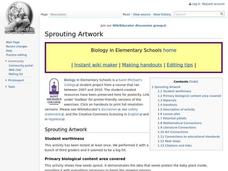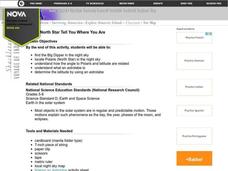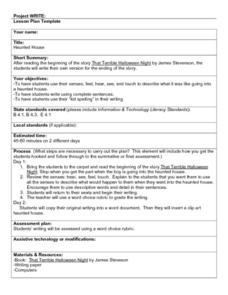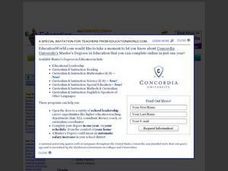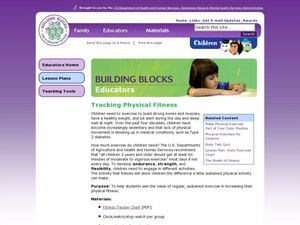Curated OER
Sprouting Artwork
Students complete activities to study seeds sprouting and plant growth. In this plant science lesson, students use mustard seeds and sponges to study the seed sprouting process. Students observe their seeds for several days and complete...
Curated OER
The New Deal
In this 1930s American history worksheet, students study the New Deal as they write 10 vocabulary terms that match 10 definitions, rewrite 4 false statements as true statements, and explain 2 historical themes regarding this time period...
Core Knowledge Foundation
Unit 2: Early American Civilizations
Fifth graders explore early American civilizations in a four-week ELA unit. Every lesson offers an opportunity to read and discuss a selected passage followed by word work that covers vocabulary, grammar, and morphology. Learners write...
Curated OER
Holidays Are a Waste of Time!
In this holiday worksheet, students, with a partner, examine, discuss and complete a variety of activities involved with celebrating holidays.
Curated OER
How does Temperature Affect Time in the Pupa Stage?
Students are guided through the Scientific Method to perform observations about the pupa stage of the monarch butterfly. The results of an experiment are used to make assumptions about growth and development.
Curated OER
Creatures That Glow In The Night
Young scholars investigate the different bioluminescent organisms. They use microscopes in order to make observations and draw what is seen. Students demonstrate they have studies the differences between the process of photosynthesis and...
Curated OER
Observing Mars in the Night Sky
Students compare and contrast the orbits of Earth and Mars, locate the planet Mars, and diagram its retrograde motion.
Curated OER
Human Body Series: Sleep
In this sleep habits worksheet, students fill out a log for one week that details sleep habits and patterns including hours slept, naps, and the energy level felt each day.
Curated OER
Let the North Star Tell You Where You Are
Students create an astrolabe and locate the North Star in the night sky. They determine the latitude of the North Star, and calculate an average latitude based on class results.
Curated OER
Let the North Star Tell You Where You Are
Students participate in activities in which they find the Big Dipper and locate the North Star in the night sky, examine the relationship between the angle to Polaris and latitude, and determine latitude by using an astrolabe.
Curated OER
Haunted House
Students are read the story "That Terrible Halloween Night". Using their senses, they describe what it is like going into a haunted house for the first time. They write their own ending to the story and share it with the class to end the...
Curated OER
"And That's The Way It Is..." Today in History
Students research an event in history from different perspectives. They discuss the characteristics of a nightly news broadcast and create their own based on the history event they researched. They work together to produce this...
Curated OER
Glue Art
Students create an art project using glue and food coloring. In this art lesson, students are given a piece of wax paper and glue is poured in the middle of the paper. Finally, food coloring is dripped on one drop at a time with the...
Curated OER
SKY PATHS: STUDYING THE MOVEMENT OF CELESTIAL OBJECTS
Students observe the position of an object in the sky by describing its location relative to another object or the background, describe an object's motion by tracing and measuring its position over time, and create their own myths about...
Curated OER
Dental Arithmetic: Sugar Clocks
Students analyze data about their teeth. For this data collection lesson, students determine how often their teeth should be brushed during the day. Students also estimate the amounts of sugar in 17 foods.
Curated OER
Do Caterpillars Eat More As They Get Bigger?
Learners observe caterpillar behavior and the amount of milkweed leaves the caterpillars eat each day. They collect data regarding the caterpillar's size and anything else they see. They look for patterns in caterpillar eating habits and...
Curated OER
Tracking Physical Fitness
Students record their daily physical activity in a chart. In this physical fitness lesson plan, students and adults exercise and see how many repetitions they can do in a given amount of time. They record this in a chart over a period of...
Curated OER
Charting Seasonal Changes
Students research the Earth's patterns of rotation and revolution, create a chart and graph of these patterns and use them to explain the causes of night and day and summer and winter.
Curated OER
Sky 2: Shadows
students will explore making shadows and tracking the movement of an object over the course of a day to look for patterns. It is best to couple this shadow activity with reading the book, Bear Shadow, and making a map of Bear's...
Curated OER
Health and Wellness
Students exercise without being in a big group. They have freedom of movement, learn particular body part at same time promote health, and enjoy exercising at a early age.
Curated OER
Sky 2: Shadows
Students explore space science by participating in a shadow experiment. In this sky observation lesson, students identify how the sun creates different sized shadows by moving across the horizon. Students utilize yard sticks, markers,...
Curated OER
Have You Ever Seen a Sea Monkey?
Fourth graders observe brine shrimp over several days. They create drawings showing the growth and development of the shrimp. They research web sites to find out where brine shrimp fit on the food chain and what makes the shrimp unique.
Curated OER
Jazz Lessons That Tell The Story
Jazz lessons can provide a look into history, and a way to talk about present day jazz musicians.
Curated OER
Energy in the Home
In this energy use activity, students read about kilowatts and solve 2 problems. They find the costs to run certain electrical items for a given amount of time and they determine the electricity consumption of an accelerator that runs...


